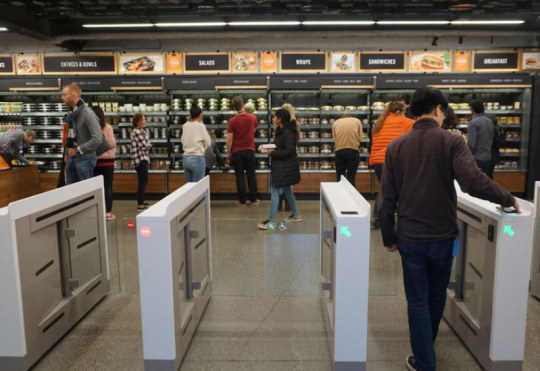
Amazon is reportedly considering a plan to open
as many as 3,000 new Amazon Go cashierless stores by 2021,
with more than 50 locations in major markets by 2019, according to Bloomberg.
While Amazon has not confirmed the report, Amazon Go stores in
major metro markets would likely take a bite out of food and beverage sales at
supermarket, drug, dollar, convenience and mass chains as consumers —
especially the growing ranks of Amazon Prime members — opt to skip the checkout
process altogether to make a quick snack, meal or grocery purchase.
The RTP team
discusses what steps retailers can take to survive in a landscape flooded with Amazon
Go stores, and whether the Go business model is sustainable.
Debbie Hauss, Editor-in-Chief:
I think the stores are coming; how many, and how quickly, is the question at
this point. But supermarket and convenience store retailers should be
preparing now for how they are going to compete. This is a disruption that
we’ve been aware of, so there’s almost no excuse for potential competitors
not being prepared. It looks like there are still a number of glitches that
Amazon is working to overcome, so now is the best time to jump in and figure
out how to perfect the technology to directly compete, or to develop different
strategies that will prevent current customers from getting pulled over to
Amazon Go.
Adam Blair, Executive
Editor: Not much about the announcement of Amazon opening 3,000 Go stores
makes sense — except for the fact that Jeff Bezos has amassed enough money and
power to change (or ignore) the rules as he sees fit. For one thing,
convenience stores generate a lot of their profits from the sale of tobacco
products (unfortunately for the health of consumers). Unmanned or lightly
manned Amazon Go stores would need to forego this product category, or figure
out some cashierless way to keep cigarettes out of the hands of minors.
Additionally, these stores may face problems in keeping their SKU counts low:
while c-stores don’t sell a ton of non-food items, when you desperately need an
aspirin or a 9-volt battery, you want to find it there. I would be less
skeptical if Amazon could scale up the technology — and work out the
merchandising kinks — to support 300 stores, much less 3,000.
Glenn Taylor, Senior
Editor: This appears to be Amazon’s classic “we can do this” moment — the
kind that gets everyone rattled in the short term while they slowly put
together something more cerebral behind the scenes. I don’t seriously see the
Amazon Go stores scaling out that far, especially to the point where other c-stores
have to worry about cannibalization of their total sales. There are some
lessons to be learned, however, particularly when it comes to introducing more “grab-and-go”
meals and creating an entirely mobile-friendly store. Plus, existing
convenience stores still carry the advantage of being the place to stop for
many things people don’t want to shop at a store for, whether that means paper
plates or even headphones. At this point, all c-stores should be doing is
keeping an eye out for what works well for Amazon Go, and starting to implement
the parts that are succeeding.
Bryan
Wassel, Associate Editor: The key to making Amazon Go a
success isn’t going to be disrupting the existing convenience paradigm, but
creating a new format altogether. The kinds of products shoppers really want
out of a grab-and-go experience are prepared foods, drinks and perhaps
ingredients for dinner, resulting in an experience that may more closely resemble
a fast-food restaurant than a traditional convenience store. While there will
no doubt be room for non-food products in the Amazon Go stores, nonperishables (outside
of packaged snacks) aren’t as likely to be items that someone will consistently
need to pick up in a hurry. For these items, most shoppers are likely to know
what they need ahead of time, and they can opt for curbside pickup on their way
home from work or another errand — something Amazon already can provide through
its Whole Foods stores.






